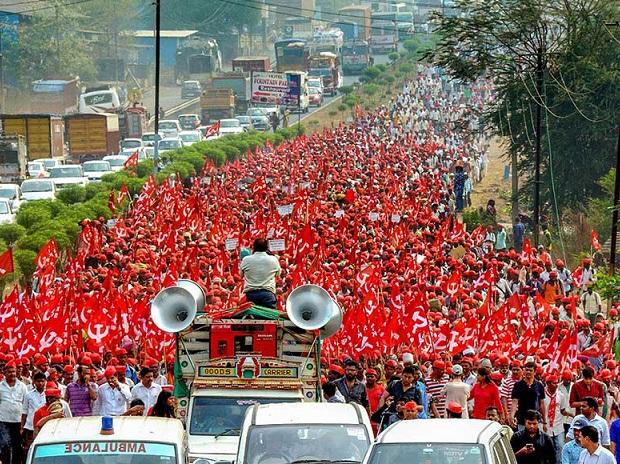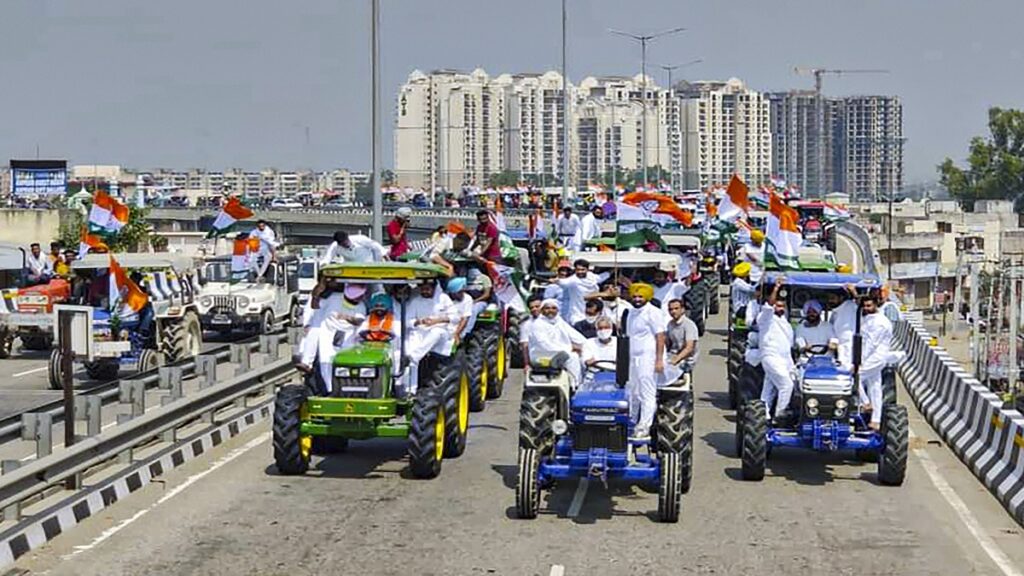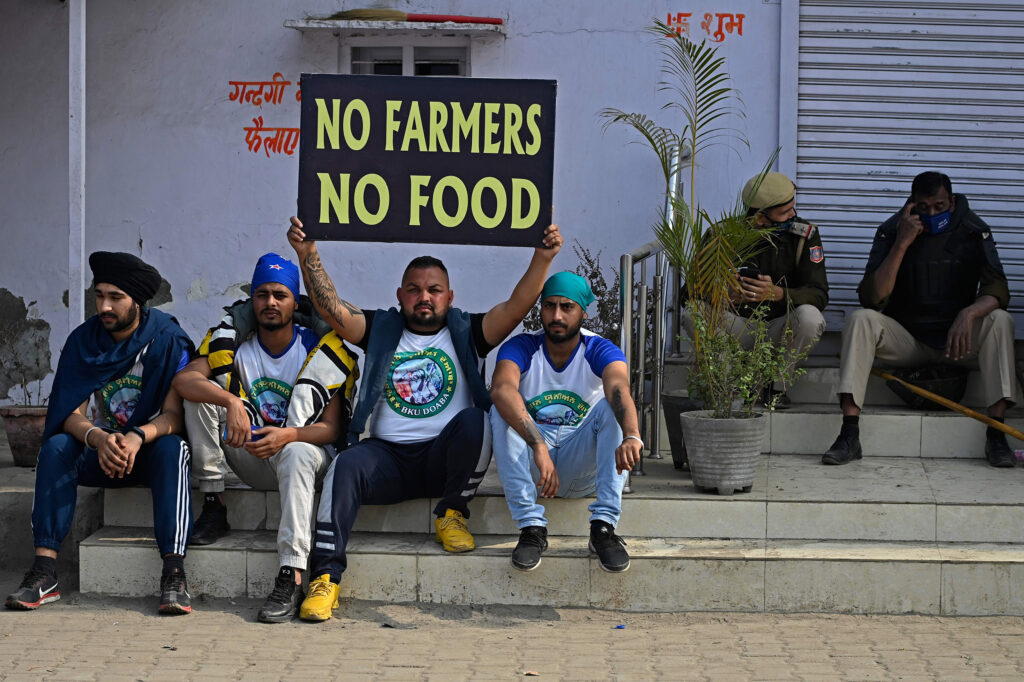Authoritarianism and resistance in India (part 1)
The largest strikes in history

Ashley Smith: The big news out of India is the farmers and workers strike. It’s been all over the news. It’s one of the largest strikes in human history. What are the causes and significance of the strike?
Nagesh Rao: Millions of workers participated in nationwide general strikes on November 26-27 and December 8 for a number of labor-related issues and in solidarity with the ongoing farmers’ protests. These strikes have been called the largest in world history. We can come back to that later but let’s first talk about the farmers’ protests. The protests are in response to three new laws that were passed by the BJP government in late September that farmers see as an existential threat to their lives and livelihood.
The new farm laws eliminate the taxes that states levy on trade in agricultural produce that takes place outside state-regulated mandis (market yards). Until now, produce could only be sold at the mandis, which facilitated sales through open auction to licensed traders and thus shielded farmers from predatory corporate practices. With these new laws, traders can bypass the mandis without tax disincentives and buy produce directly from farmers. The government claims that they aren’t getting rid of the mandis, but it’s clear that by opening them up to market competition they want to render these public procurement centers obsolete. The new laws also legalize contract farming with predetermined pricing and they eliminate the cap on stockpiling of agricultural produce. Corporations will now be able to buy up produce from destitute and desperate farmers without having to bid for it in a mandi, hoard the produce, and use the stockpiles to manipulate markets and prices. Each of these laws individually would spell disaster for rural populations already in distress; taken together they are going to be catastrophic.
It doesn’t end there. Historically, at the mandis the government would procure farmers’ produce at something called the “minimum support price” (MSP). The government, via agents in charge of procurement at mandis, would then ensure that bidding doesn’t go below the MSP. Under the new farm laws, with mandis rendered obsolete, the MSP will also disappear, leaving prices to the whims of the market and the wishes of corporate traders.
Worse still, activists fear that by ending this system of government procurement, the BJP is pulling the rug out from under the Public Distribution System which provides subsidized foodgrain and essential commodities to the poor.
These are the immediate causes of the protest movement.

Aaron Amaral: How do the changes contemplated by these proposed laws fit in the recent history of government policies towards the agricultural sector?
NR: The roots of the farmers’ distress are much older. Rural India is in a deep crisis whose origin lies in the 1960s Green Revolution. In the name of increasing agricultural productivity, the Green Revolution made Indian farmers dependent on multinational corporations for hybrid seeds. A few decades later came “terminator” seeds, which are genetically modified to ensure that the second generation of seeds will be infertile, making farmers even more dependent on corporations that own the patents to these genetically modified seeds. It also resulted in more capital-intensive and chemical-dependent agriculture, as monoculture of particular crops degraded the soil and dramatically reduced its yield. The Green Revolution, and neoliberal reforms that began in the 1990s, created an increasingly impoverished and indebted rural population. According to data from 2019, nearly 365,000 farmers have committed suicide since the 1990s. This is certainly an underestimation, because the rural poor, particularly the specially oppressed groups among them, such as landless Dalits (literally the “oppressed” or “crushed”, the term of self-identification adopted by those ostracized by caste Hindus as “untouchable”) or women, often don’t even register in official statistics.
So it’s not surprising to see this massive eruption of protest. It didn’t come out of nowhere. Farmers’ protests have been going on for several years and they have culminated now in hundreds of thousands of farmers, many of them elderly, occupying and blocking highways leading into Delhi in bitter cold and rain, refusing to yield unless the government scraps these new laws.
AS: Can you talk a little about the character of the protests and their significance?
NR: The protests began in late September in several states—in Punjab and Haryana in particular, where the impact of the Green Revolution has been felt the most, and where farmer indebtedness is really high—and by November had escalated into a call to march on Delhi, the nation’s capital.
Despite the pandemic, hundreds of thousands of farmers, driving tractors laden with tons of supplies, arrived on the outskirts of Delhi where they were met by a massive police presence wielding not only long wooden lathis but also water cannons and tear gas.
Here and there, farmers used their tractors to break through police barricades. The police dug up the highways in a desperate bid to prevent the farmers from entering Delhi. So the farmers sat down where they were, and have since occupied several miles of different roads and highways leading into Delhi.
The occupations quickly turned into tent cities with medical stations, langars (free community kitchens, many of them set up by local gurdwaras), libraries, and even an exemplary multilingual protest newspaper, Trolley Times. The temperature is near freezing in and around Delhi this time of year, and dozens of protesting farmers have died because of the freezing cold, but the farmers have so far refused to give up their main demands–repeal the new farm laws and make the MSP into a law.
Then came the massive nationwide general strikes on November 26-27 and December 8. Now to be frank, symbolic one- or two-day general strikes have become annual rituals in India. Workers have plenty to strike about for sure, but when I hear numbers like 250 million, I take it with more than a pinch of salt. Unions are fond of exaggerating the extent of their members’ participation, and the left press is fond of exaggerating their mobilizing capacity and influence.
Nevertheless, many millions did participate in the “Bharat Bandh” (literally, “Shut Down India”). The strikes had been planned for months against privatization and four anti-labor laws passed around the same time as the farm bills. These laws would make it easier for businesses to fire workers while making it more difficult for workers to form unions or to strike, and would allow the government to exempt new factories from occupational safety and health mandates.
So the general strikes this time had more than symbolic value and helped generalize the anger against the government because they were occurring during the ongoing farmers’ agitation. Workers were shutting the country down as farmers were occupying highways and being tear-gassed and water-cannoned near the nation’s capital.

Spearheading the highway occupations is a coalition of 45-50 different farmers unions and organizations that have come together as the Samyukta Kisan Ekta Morcha or United Farmers Front. In the many videos and reports that they have put out, in their press conferences, and in news reporters’ interviews with individual protesters, you can sense a mood of defiance and resolve, and a uniformly anti-Modi, anti-corporate sentiment.
Eight rounds of talks with the government have gone nowhere, and another round of talks has been announced for January 15. If the laws aren’t repealed, the leaders of the Front have declared that they will break through the police barricades and march into the capital on January 26, a day of national pomp and ceremony known as Republic Day, when the Prime Minister addresses the nation from the ramparts of Delhi’s Red Fort after a military parade. When farmers say “Instead of Modi, we will address the nation on Republic Day,” and it sounds like they actually mean it—that’s inspiring.
Time and time again you hear them say, “These laws are about stealing our land and our livelihoods, it’s about enriching corporations at the expense of our lives.” It seems to me that anti-corporate sentiment is clearer and more pronounced in these protests than in the past. While the farmers’ protest movement has been ongoing for several years now, earlier protests often framed the issue as one of representation–the government wasn’t listening to them, so they were going to Delhi to be heard. It was easy then for opposition politicians to pose as spokespersons for disenfranchised masses. This time around, farmers are framing the issue squarely as a struggle against corporate capital and its enablers in Delhi. You hear them say how these laws are about enriching Mukesh Ambani and Gautam Adani (combined net worth of over $100 billion) and their giant multinational corporations, Reliance Industries and the Adani Group.
Modi’s government, for its part, has unleashed the police, slandered the movement, spread lies and shameless propaganda, and set their infamous IT Cell to work, presenting a false narrative of naive peasants led astray by … you name it—Khalistani terrorists (the reference is to a separatist movement in Punjab that was brutally crushed by the Indira Gandhi government and no longer has much traction in the state), agents of Pakistan, Maoists, and “anti-national” elements (see “tukde-tukde gang”) who don’t want the farmers to realize how much they will benefit from the free market. All this while claiming that there is no farmers protest—look, they are wearing shirts and shoes, they couldn’t possibly be farmers! And the mainstream media have uniformly and shamelessly reinforced these talking points.
Modi and Amit Shah, the Home Minister, are no doubt trying to divide the movement as well–new farmers’ organizations have magically sprung up out of thin air and are being feted in the halls of government as supporters of the farm laws, for instance. And they will no doubt try to deepen any fissures that might appear between the liberal and left wings of the united front.
But so far, it appears that all of their efforts to discredit or marginalize the movement have failed miserably because it’s really difficult to vilify and demonize peasants and farmers in India. I think this protest movement is going to continue to grow and could well deliver Modi’s first major policy defeat.

AA: Didn’t the Supreme Court just suspend the farm laws? Is this a victory?
NR: Nothing of the sort. When I saw the headlines this morning I almost choked on my coffee. The Supreme Court of India, suddenly ruling against Modi and Shah? What’s going on? It turns out that the Court issued a temporary injunction against implementation of the laws and set up a committee of “experts” to “investigate” the matter. Farmers though are having none of it. First of all, they say there’s no reason for the court to get involved. They are not interested in debating the legality of the laws; they want the government to repeal them. Second, all four of the so-called experts appointed to the committee by the Court are known to have expressed support for the farm laws in recent months. So this is both a stalling tactic on the part of the government, and could potentially lead to some sort of court injunction against the farmers in the future (after the “experts” have done their work). Not satisfied with intervening when no one asked them to, Chief Justice Bobde also took the opportunity to demonstrate his sexism, admonishing farmers unions for “bringing” women to the protest, and saying that they should be “sent back” home if the protests continue.
The fact is, the Supreme Court of India has consistently upheld Modi’s agenda and aided the Hindu nationalist forces in its recent rulings. The Court did nothing when the government revoked Kashmir’s autonomous status on August 5, 2019, placing the entire state under curfew and lockdown and a total communications blackout for nearly a year (even today Kashmiris only have 2G internet services). Later the same year, the Court issued an extraordinary ruling in the decades-long dispute over the site of a 500-year-old mosque, the Babri Masjid, that was demolished in December 1992 by Hindu nationalist mobs egged on by BJP politicians claiming that this was the birthplace of the Hindu god Ram. It ruled that the demolition of the mosque was wrong (but didn’t state who was to blame or who would be punished for this wrong), and then granted ownership of the site to the Hindu trust that will ensure the construction of a Ram temple at the site!
This is why these protests are so significant. Winning the elections in 2019 for a second term with an outright majority and with a subservient judiciary to back them up, the BJP have adopted an accelerationist approach to dismantling and selling off what’s left of India’s public sector, consolidating authoritarian rule at the center vis-a-vis the states, and realizing the Hindutva movement’s dream of a Hindu nationalist state. We can talk more about this later, but when Modi appointed chief pogromist Amit Shah he was sending a signal—Modi 2.0 will be about consolidation of authoritarian power at the center. So it was really heartening to see the government rocked by mass protests and public sit-ins (the one in Shaheen Bagh became iconic) involving tens of millions against new anti-Muslim citizenship laws for months in late 2019 and early 2020, until they were violently disrupted on campuses and on the streets by Hindu chauvinist mobs aided by police.
Then came the brutal COVID lockdown, carried out with the disregard for human life that is characteristic of the upper castes in Hindu society. After weeks of denying and mystifying the disease, Modi announced the lockdown only four hours before it went into effect. Tens of millions of migrant laborers, stranded in locked-down cities then began to walk back to their villages, sometimes hundreds of miles. Several died.
After these setbacks, it feels a bit like the return of that spirit of protest, this time from the rural heartland (the anti-CAA/NRC movement was mostly urban).
AA: When you talk about farmers, is that primarily who you’re talking about? People who don’t own the land, who are in debt crises? What’s the demographic of the protestors?
AS: Are these tenant farmers, landless laborers, small holders?
NR: The protests have galvanized broad swaths of the rural population, including landless laborers, sharecroppers, tenant farmers, landholding peasants, even rich farmers, agents, traders, and mandi workers. Other segments of the rural and semi-urban populations are participating and showing solidarity in various ways, offering free services (haircuts and the like) to the protesters. Many of those who couldn’t join the protests are maintaining the farms and crops of those who are protesting.
As I said earlier, rural India has been in an ever-deepening crisis since about the first decade after the Green Revolution ,when the initial spurt of growth and productivity fueled by the new methods petered out. As soil denudation and water-table depletion took root and began impacting profitability, successive governments have turned a blind eye to the underlying problems and instead have been handing out (smaller and smaller) subsidies and forms of income support to keep the system going, to keep farmers from starving, and to gain votes.

Neoliberal reforms, which began in 1992, exacerbated the crisis. Waves of privatization and retrenchment played havoc with ordinary people’s lives. From 2001-2011, the number of cultivators with land holdings fell by 8.5 million, while the number of landless laborers increased by 37.5 million. Subsidies and employment schemes have done little to lift people up.
According to a report by the Network of Rural and Agrarian Studies (NRAS), the national average daily wage rate for male and female field labour was Rs 315 ($4.29) and Rs 244 ($3.33) respectively in 2017-18. That’s the plight of the landless laborers.
The majority of the landholders are classified as small or marginal. Marginal landholdings (smaller than 1 hectare) are 68% of the total, and in these households, consumption expenditure exceeds income (Rs 5000, or about $70 a month for a family of five on average), meaning that they are trapped in a cycle of mounting debt from year to year. Then you have tenant farmers leasing land at $200 or $300 a year but not producing enough to pay the lease or to even have something to sell at the mandi.
There are these class differences among the protesting farmers. There are also caste differences. For example, most landless laborers are Dalits (literally “oppressed” or “crushed,” the term of self-identification adopted by those ostracized by caste Hindus as “untouchable”). There are political differences as well; there are nearly 50 organizations and unions involved. Members of one prominent progressive union, the Bharatiya Kisan Union (Ekta Ugrahan) protested on Human Rights Day with pictures of left-wing scholars and activists jailed by the Modi regime. A leader of another union, when asked to defend this action, denied it ever took place. On the other extreme there is the Shiromani Akali Dal, an ally of the BJP. How these differences might play out as the movement develops remains to be seen.
AS: To what extent can we claim that the farmer’s strike is a challenge frontally to Modi’s project and a shift from a kind of caste and religious standpoint to a class struggle standpoint?
NR: This is first of all a movement fighting desperately to maintain and extend state regulation (mandis), price supports (MSP), and subsidies in the face of neoliberal privatization, deregulation, and austerity. So it is a challenge to the neoliberal project that has been pursued not only by Congress and BJP governments alike, but also by the parliamentary left when it was in power in West Bengal. Second, it is bringing to the fore sustainability issues by demanding that more crops be covered by the MSP, as this would re-incentivize crop rotation. Third, it strikes at the heart of Modi’s political project of consolidating power at the center. People are angry about the anti-democratic manner in which the laws were passed, throwing Modi’s authoritarianism into relief.
If we follow Achin Vanaik’s argument, independent India has always been an “authoritarian democracy”; under Modi that authoritarianism is being put in the service of a radical Hindutva agenda. Given this, the farmers’ discontent with Modi’s trampling of federalism, their derision of the corporate media, and their solidarity with leftist scholars, lawyers, and activists jailed by Modi’s regime are all welcome developments from a political and democratic rights standpoint and could open up the space for discussing hitherto neglected subjects like the eradication of caste or the state’s war on Adivasis. We’ll have to see.
But I think the movement remains constrained by its cross-class character, and thus reflects a common denominator of demands. For example, the mandi system is ridden with corruption and patronage and often controlled by bureaucrats and “local, regional, or national oligopolies,” as the recent NRAS report puts it, but I haven’t come across demands calling for making the mandis more transparent, accountable, or open to competition from smaller cooperatives or traders to break the oligopolies.
Nor have I seen a demand for a living wage for landless workers, for instance. The absence of such a demand might reflect the caste makeup of movement leadership, as most landless workers are Dalits.
It’s not about shifting the struggle from the terrain of caste to that of class. There is no terrain of class struggle in India that is not, at the same time, shaped by the caste system, because caste is both a division of labor and a division of laborers, in the words of Dr. B. R. Ambedkar (the Dalit scholar and leader who led the committee that drafted India’s Constitution). Class struggles necessarily come up against the caste question. Dalit emancipation and the eradication of caste has to be central to the working class struggle, not least because the broad masses of workers and peasants in India either belong to oppressed castes or are Dalits; the annihilation of caste has to become a working class demand. While mass movements of farmers and workers can unite people of different castes behind specific demands, this does not automatically negate or diminish the caste divisions within the movement. For that to happen, there will have to be concerted anti-caste activism embedded within the struggle, taking up demands that are critical for Dalit emancipation and caste eradication.
AS: What are the class forces behind Modi? What classes are pushing for these new laws?
NR: Just as in the U. S., so also in India the big capitalists back both the major parties, but in the last election cycle the BJP’s corporate donations dwarfed that of the Congress Party, with the Tata Group (the underwriters of the Congress Party back its heyday) leading the pack–they are all firmly behind Modi.
The capitalist class wants to be done with the Nehruvian past and its political hangers-on, the family-owned business known as the Congress Party. True, Congress opened the door to liberalization, but they see the BJP as less beholden to the working classes than Congress and more willing to force through further reforms.
Nagesh Rao is a Lecturer at Colgate University, a proud father of two, and a long-time socialist who grew up in Bangalore and now lives near Syracuse, NY.
Categories
We want to hear what you think. Contact us at editors@tempestmag.org. And if you've enjoyed what you've read, please consider donating to support our work:
DonateAaron Amaral & Ashley Smith View All
Ashley Smith is a member of the Democratic Socialists of America in Burlington, Vermont. He has written in numerous publications including Spectre, Truthout, Jacobin, New Politics, and many other online and print publications.
Aaron Amaral is a member of the Democratic Socialists of America, the Tempest Collective, and on the editorial board of New Politics.
